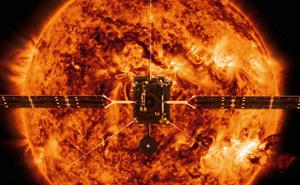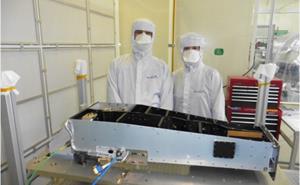It launched from Cape Canaveral today (Monday 10 February) at 04:03 am GMT on board an Atlas V 411 rocket.
After more than 10 years in development, Solar Orbiter will provide scientists with a long awaited insight into some of the mysteries surrounding our nearest star.
The mission will travel within the orbit of Mercury to get up close to the Sun, climb out of the ecliptic and give us the first ever view of the Sun's poles. These observations will help us understand changes in the solar activity and discover what drives the solar wind, the stream of charged particles which are ejected from the Sun and travel through the solar system.
Business Secretary Andrea Leadsom said: “Solar storms could cause major disruptions to technologies including our energy grid, mobile phone signal and navigation systems.
“This new mission demonstrates the UK's leading role in the global space industry, while supporting our economy, creating jobs and helping establish the UK as a global science superpower."
 UK scientists and engineers have played a leading role in the mission. STFC's RAL Space, University College London and Imperial College London have led international teams to design and build three of the 10 science instruments on board. These instruments will look at the environment around the Sun as well as undertake high-resolution imaging of the Sun's atmosphere – the corona – as well as the solar disc.
UK scientists and engineers have played a leading role in the mission. STFC's RAL Space, University College London and Imperial College London have led international teams to design and build three of the 10 science instruments on board. These instruments will look at the environment around the Sun as well as undertake high-resolution imaging of the Sun's atmosphere – the corona – as well as the solar disc.
The Spectral Investigation of the Coronal Environment (SPICE) instrument was led from RAL Space, the UK's national space laboratory. Dr Andrzej Fludra, the RAL Space scientist who led the international consortium for the SPICE instrument was at Cape Canaveral to witness the launch: “It was amazing to see Solar Orbiter launch, it feels like the crowning of the effort of our large team. The next exciting moment will be taking the first spectra of the Sun, and initial observations to check the instrument.
"After a long cruise, when the proper science mission begins at the end of 2021, we will have a long list of observations to take of many targets on the Sun, to measure the flows of plasma in the Sun's atmosphere, its composition and its wide range of temperatures. All Solar Orbiter instruments will combine their data to get the most detailed understanding of how the Sun works and how its low corona is connected to the inner heliosphere."
SPICE will help trace solar wind structures measured at the spacecraft, to their sources at the poles inside dark, slightly cooler areas of the Sun known as coronal holes. Previous missions have looked at how solar winds move out across the Solar System but we know little about their origin at the Sun.
 More than 85 people from across Europe and the USA were involved in the SPICE instrument alone.
More than 85 people from across Europe and the USA were involved in the SPICE instrument alone.
The team are now waiting to see how the spacecraft fares on its journey to the Sun. The spacecraft, which is protected by a heatshield, has been tested to withstand temperatures up to 500֯C. The instruments on board will need to operate perfectly in these challenging conditions. SPICE will allow all of the light from the Sun in and will filter out excess light, using only two bands in extreme ultraviolet wavelengths.
The spacecraft will use gravitational assists from the Earth and Venus to arrive at the Sun at the end of 2021. Later, it will gradually climb out of the ecliptic in order to observe the Sun's poles. At its closest, the spacecraft will be just 42 million kilometres away from the Sun.
Notes:
Images:
Middle: Artists impression of Solar Orbiter. Credit: ESA/ATG medialab; Sun: NASA / SDO / P. Testa (CfA)
Bottom: SPICE in the cleanroom at RAL Space. Credit: STFC RAL Space
STFC RAL Space
RAL Space is an integral part of the Science and Technology Facilities Council's (STFC) Rutherford Appleton Laboratory (RAL) and is the space hub for UK Research and Innovation. RAL Space carries out world-class space research and technology development with involvement in over 210 space missions.
Twitter: @RAL_Space_STFC
UK involvement in Solar Orbiter
The prime contractor for the satellite is Airbus Defence and Space in Stevenage. UK teams from University College London, Imperial College London and the Science and Technology Facilities Council's RAL Space are involved in 4 out of the 10 instruments. The UK Space Agency is funding the UK involvement.
The UK is a global leader in solar science with organisations like RAL Space working at the forefront of efforts to understand our nearest star and assess and mitigate the impact of space weather on Earth.
As well as leading instrumentation for science missions like ESA's Solar Orbiter and NASA's STEREO mission, RAL Space is leading an international team developing instruments for ESA's Lagrange mission which will be part of an early warning system for severe space weather and working with the Natural Environment Research Council on a new £20 million fund to connect the space weather research community with the Met Office Space Weather Operations Centre.
